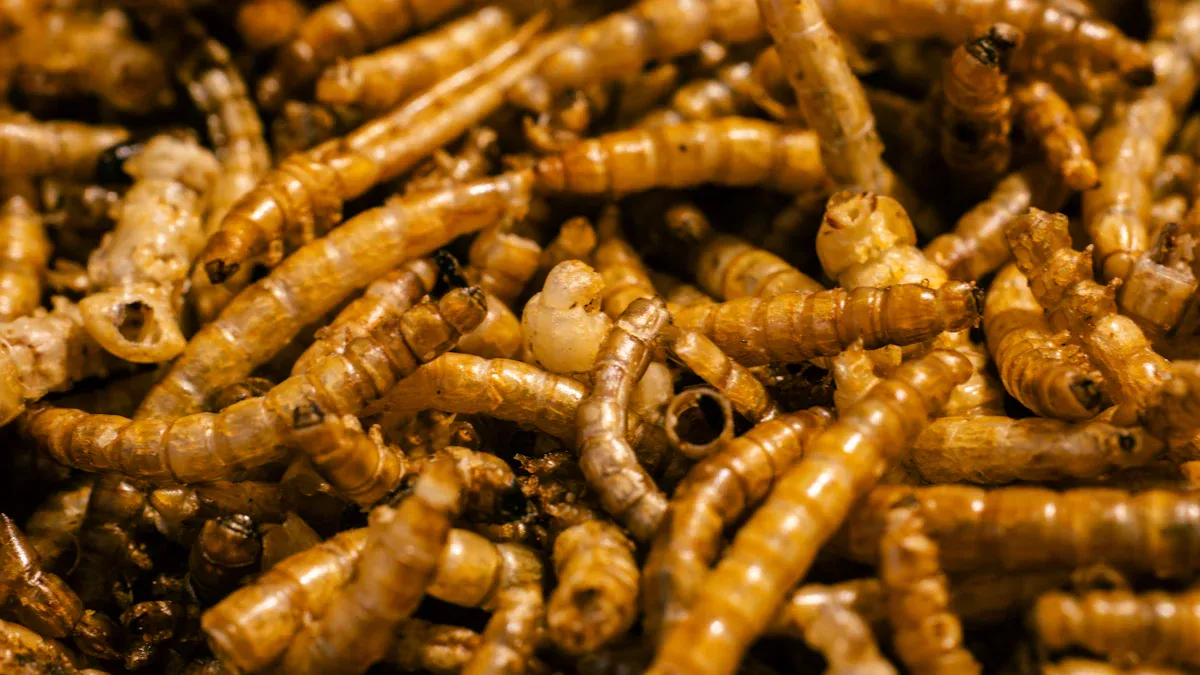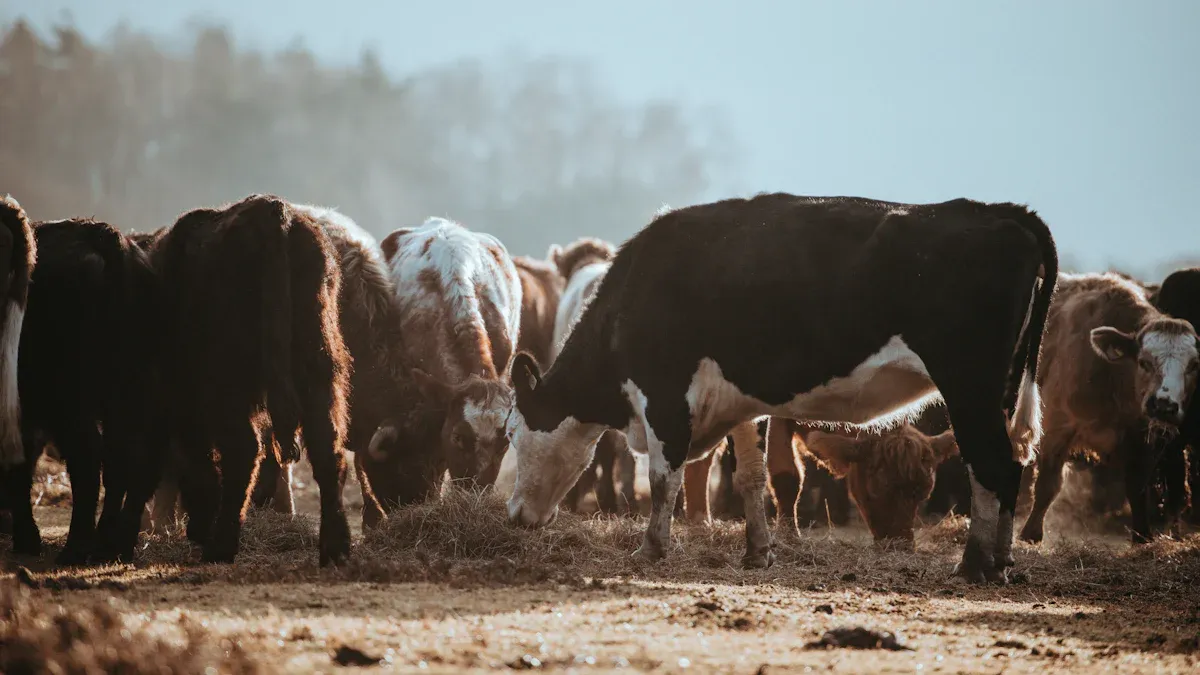
Sustainable feed solutions are transforming livestock farming. Did you know improving feed conversion ratios (FCR) has boosted efficiency since the 1950s? Natural dry mealworms are a game-changer. They pack 48% protein, rivaling soy, and require 500 times less water. Plus, their frass enriches soil, indirectly benefiting livestock. A trusted mealworm supplier can help you make the switch.
Key Takeaways
- Dry mealworms are eco-friendly, using 500 times less water than soy. They also release fewer harmful gases into the air.
- Mealworms have 48% protein and important nutrients. They help animals grow healthier and stronger than regular feed.
- Adding mealworms to animal diets saves money and resources. This makes them a great option for farmers wanting better results.
What Are Natural Dry Mealworms?
Life Cycle of Mealworms
Mealworms go through four main stages in their life cycle: egg, larva, pupa, and adult beetle. It all starts with tiny eggs laid by adult beetles. These eggs hatch into larvae, which are the mealworms you’re familiar with. The larval stage lasts about 10 weeks, during which they grow by feeding on grains like wheat bran and maize. Afterward, they transform into pupae, a resting stage where they don’t eat or move much. Finally, they emerge as adult beetles, ready to start the cycle again.
Mealworms are efficient feeders. They only need 2 pounds of food to produce 1 pound of mealworms. Compare that to cattle, which require 8 pounds of feed for the same output. Plus, mealworms thrive in small spaces and can be raised vertically, making them perfect for large-scale production. Their feed conversion ratio (FCR) is as low as 2.2, far better than cattle’s 8.52.
| Metric | Value |
|---|---|
| Average rearing duration | 100 days |
| Feed composition | Wheat bran (70%), maize (12%), brewer’s yeast (10%), lucerne (8%) |
| Net feed conversion ratio | 3.61 (carrots excluded) |
| Minimum feed conversion ratio | 2.2 |
| Average FCR in cattle | 8.52 |
Characteristics That Make Mealworms Suitable for Livestock Feed
Mealworms are packed with nutrients. They contain 48% protein, which is almost as high as soy, and they provide more energy per pound. Their ash and crude fiber content are lower than soy, making them easier for livestock to digest. This means your animals get more nutrition from every bite.
| Characteristic | Mealworms | Soy |
|---|---|---|
| Protein Content | 48% | 50% |
| Total Energy per Pound | Higher | Lower |
| Ash Content | Lower | Higher |
| Crude Fiber Content | Lower | Higher |
Another great thing about mealworms is their sustainability. They need less than half a gallon of water per pound produced, which is 500 times less than soy. They can also be fed on biowaste, which not only enriches their nutritional profile but also helps manage waste. Plus, they grow well in confined spaces, reducing their carbon footprint. These traits make natural dry mealworms an eco-friendly and efficient choice for livestock feed.

Nutritional Benefits of Natural Dry Mealworms

Protein and Essential Nutrients for Livestock Growth
When it comes to protein, natural dry mealworms are a powerhouse. They contain 48% protein, making them an excellent source for livestock growth. What’s even better? They provide all essential amino acids, which are crucial for building muscle and maintaining overall health in animals. In fact, the total concentration of amino acids in mealworms is an impressive 951 mg/g, with half of that being essential amino acids. This makes them a complete protein source, unlike many traditional feeds.
Mealworms also offer more energy per pound compared to soy. This means your livestock gets more out of every bite, helping them grow faster and healthier. Plus, their lower ash and crude fiber content make them easier to digest, ensuring better nutrient absorption.
Comparison with Soy and Fishmeal
How do natural dry mealworms stack up against conventional feeds like soy and fishmeal? Let’s take a closer look:
| Nutritional Aspect | Mealworms | Soy |
|---|---|---|
| Protein Content | 48% | 50% |
| Total Energy per Pound | Higher | Lower |
| Ash Content | Lower | Higher |
| Crude Fiber Content | Lower | Higher |
Mealworms also have a feed conversion ratio (FCR) of 2:1, far better than cattle’s 8:1. This means they convert food into body weight much more efficiently. Unlike larger livestock, mealworms are consumed whole, leaving no waste behind. Their production requires significantly less water than soy, making them a more sustainable and cost-effective option.
Enhancing Livestock Health and Development
Feeding your livestock natural dry mealworms doesn’t just boost growth—it improves their overall health. The high protein content supports muscle development, while the essential amino acids enhance immune function. This leads to stronger, healthier animals that are less prone to disease. The energy-dense nature of mealworms also ensures your livestock stays active and productive.
By choosing mealworms, you’re not just feeding your animals; you’re investing in their long-term well-being. Their superior nutritional profile makes them a smart choice for farmers looking to optimize livestock health and performance.
Environmental Advantages of Using Natural Dry Mealworms
Reduced Resource Consumption
Switching to natural dry mealworms as livestock feed can save a surprising amount of resources. Mealworms require significantly less land, water, and energy compared to traditional feed sources like soy or fishmeal. For example, mealworm production uses only 43% of the land needed for milk and a mere 10% of what beef requires. This makes them an excellent choice for farmers looking to reduce their environmental footprint.
| Resource Type | Mealworms | Milk | Chicken | Pork | Beef |
|---|---|---|---|---|---|
| Land Use (LU) | Very low (1.81–3.23× lower) | 1.81–3.23× higher | 2.30–2.85× higher | 2.57–3.49× higher | 7.89–14.12× higher |
| Fossil Energy Use (EU) | 21–83% of milk | 21–83% higher | 46–88% higher | 55–137% higher | 1.02–1.58× higher |
Mealworms also consume less water and energy during production, making them a sustainable alternative to conventional feeds. By choosing mealworms, you’re not just feeding your livestock—you’re conserving vital resources.
Lower Carbon Footprint
Natural dry mealworms have a much smaller carbon footprint compared to other feed sources. Their production emits fewer greenhouse gases (GHGs) and uses less non-renewable energy. In fact, mealworms produce 23% fewer GHG emissions and use 18% less non-renewable energy than broilers. They also occupy 70% less agricultural land, which helps combat deforestation and habitat loss.
| Metric | Mealworms | Broilers |
|---|---|---|
| GHG Emissions (GWP) | 23% less | Baseline |
| Non-renewable Energy Use (NREU) | 18% less | Baseline |
| Agricultural Land Occupation (ALOP) | 70% less | Baseline |
| Terrestrial Acidification Potential (TAP) | 72% less | Baseline |

By reducing emissions and energy use, mealworms contribute to a cleaner, greener planet.
Contribution to Waste Management and Circular Economy
Mealworms play a vital role in waste management and the circular economy. They can upcycle biowaste, such as food scraps and agricultural byproducts, into valuable biomass. This not only reduces waste but also enhances the nutritional profile of the mealworms themselves. For instance, mealworms fed on organic sidestreams show increased fat and mineral content, making them even more beneficial for livestock.
| Evidence | Description |
|---|---|
| Upcycling Biowaste | Mealworms convert biowaste into valuable biomass, enhancing sustainability. |
| Nutritional Profile | Organic sidestreams improve mealworm fat and mineral content. |
Mealworm frass (excretions) is another hidden gem. It’s rich in nitrogen, potassium, and phosphates, making it a sustainable alternative to traditional fertilizers. By using mealworms, you’re not just feeding your animals—you’re also enriching the soil and reducing agricultural waste. This creates a win-win situation for farmers and the environment.
Practical Integration of Natural Dry Mealworms in Livestock Diets
Farming and Processing Techniques
Raising mealworms for livestock feed is simpler than you might think. These insects thrive on agricultural byproducts like wheat bran, maize, and even food waste. This makes them an excellent option for upcycling materials that would otherwise go unused. You can grow mealworms in stacked trays, saving space and maximizing production. Their short life cycle means you’ll have a steady supply in just a few weeks.
Processing mealworms into high-quality feed involves several steps. Defatting is one of the most effective techniques to enhance protein concentration. After defatting, sifting separates chitin from protein, improving digestibility for livestock. Advanced methods like alkaline and acid precipitation can produce nearly pure protein extracts, while browning inhibitors ensure a lighter, more appealing product. These techniques not only improve the nutritional value but also extend shelf life, making mealworm powder a reliable feed ingredient.
Feeding Methods for Different Livestock Types
Mealworms are versatile and can be fed to various livestock. For poultry, you can mix mealworm powder with grains to create a balanced diet. Chickens especially benefit from the high protein content, which supports egg production and muscle growth. For pigs, mealworms can replace a portion of soy-based feed, providing a more digestible protein source. Even fish farms are incorporating mealworms into aquaculture diets, as they mimic the natural prey of many fish species.
Want to get creative? Some farmers use mealworms as a live feed for chickens, encouraging natural foraging behavior. This not only enriches the animals’ diet but also keeps them active and healthy.
Cost-Effectiveness and Scalability for Farmers
Switching to natural dry mealworms can save you money and resources. Producing mealworms requires only 43% of the land needed for milk protein and just 10% of what beef production demands. They also consume less water and feed, making them a cost-effective alternative to traditional livestock feed. Plus, mealworms emit fewer greenhouse gases, aligning with the growing demand for sustainable farming practices.
Scaling up mealworm production is easier than you might expect. Their ability to thrive in small spaces and on waste streams makes them ideal for large-scale operations. Farmers have successfully integrated mealworms into circular farming systems, such as using rabbit manure to grow mealworms, which are then fed to chickens. This closed-loop approach reduces waste and maximizes efficiency, proving that mealworms are not just sustainable but also economically viable.
Tip: Start small by incorporating mealworms into a portion of your livestock’s diet. Gradually increase their share as you see the benefits in growth, health, and cost savings.
Natural dry mealworms are a win-win for your livestock and the planet. They boost animal health with high protein and essential nutrients while cutting greenhouse gas emissions, land use, and water consumption. By switching to this sustainable feed, you’re not just improving your farm’s efficiency—you’re contributing to a greener future.
FAQ
What makes mealworms better than traditional livestock feed?
Mealworms are rich in protein, require fewer resources, and have a lower carbon footprint. They’re sustainable, cost-effective, and packed with essential nutrients for livestock growth.
Can I feed mealworms to all types of livestock?
Yes! Mealworms work for poultry, pigs, and even fish. You can mix them into feed or use them as live treats for added enrichment.
How do I start incorporating mealworms into my livestock’s diet?
Start small. Replace a portion of traditional feed with mealworm powder. Gradually increase the amount as you observe improvements in growth and health.
Tip: Consult a nutritionist to ensure balanced diets for your animals.


